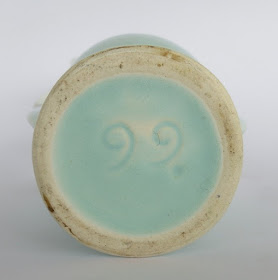So today I did a bit of a wander round our house with the camera and picked out a few of my favourite things.. first up is our new Ming dinner set, a lucky TradeMe buy at $45. Ming was designed in the 1980s by Percy Golding. He is very proud of it and I can understand why. Just look at the detail in this plate. All done in pre-computer days too.
Ming is from the Contemporary Ceramics range of the early 1980s. And it's still in perfect condition, this range was very well made. Also in the kitchen are these mugs. They never get used but every day I enjoy looking at them. Note Basil Brush, top centre, a gift from a very generous friend. You don't see him very often!
Speaking of mugs, these cheery little numbers live in on a shelf in the lounge and brighten up our winter days. The one on the left is probably 1970s, the other is 1980s.
Most of these mugs have Made in New Zealand on the base like this:
This post would not be complete without mentioning my swans. They lived in a box in the shed for years, but then I weakened and liberated them.. and now I quite like having them around. The big one is the less common 'male' shape; the other is the smallest of the 3 sizes made by Crown Lynn.
And now for something completely different, here is a very old shaving mug. I bought it complete with brush, no doubt some poor old granddad's relic. I love the shape of this mug and it's in good condition when you consider it was made in the 1940s or early 1950s. (Later comment: this is almost certainly 1940s, or even late 1930s, rather than 1950s)
The base is unmarked.
If you look closely you can see the crazing that mars many of Crown Lynn's products. After an object has been through the kiln it continues to shrink, very very slightly. If the glaze shrinks a bit faster than the clay body then the glaze cracks, causing crazing.
And on that merry note I will leave you. I hope you have a lovely Xmas/New Year break. I will be camping again for the next few weeks so I probably won't be doing another post until mid-January... unless I find something utterly magical in a junk shop that I absolutely have to tell you about!
Take care
ValM


















































